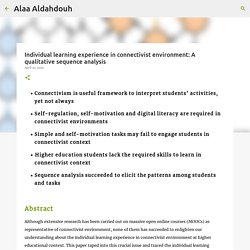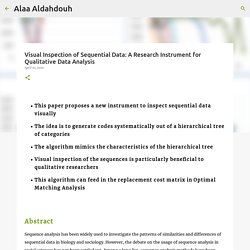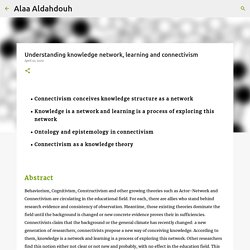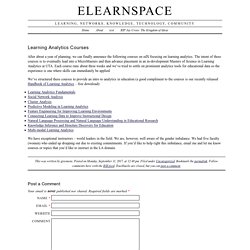

Emotions Among Students Engaging in Connectivist Learning Experiences – Alaa Aldahdouh. Negative emotion is not always harmfulNegative-activating emotions have positive impact on students’ performanceNegative-activating emotions dominate students feeling in online learningConnectivist learning environments arouse negative emotions of higher education students Emotion has long been a question of great interest in a wide range of fields.

As a general rule, emotions are categorized as positive, which we seek, and negative, from which we turn away. However, empirically-backed connectivists claim that even negative emotions produce positive effects on student performance. What is less clear is how this process happens. This study had two primary aims.
Read more here. keywords: connectivism emotioncontrol-value theoryonline learninghigher education Cited as: AlDahdouh, A. Planning to design mooc think first! Understanding Connectivism. Connectivism: Education & Artificial Intelligence. Emotions in connectivist learning experiences. Emotions Among Students Engaging in Connectivist Learning Experiences. Individual learning experience in connectivist environment: A qualitative sequence analysis. Connectivism is useful framework to interpret students’ activities, yet not alwaysSelf-regulation, self-motivation and digital literacy are required in connectivist environmentsSimple and self-motivation tasks may fail to engage students in connectivist context Higher education students lack the required skills to learn in connectivist contextSequence analysis succeeded to elicit the patterns among students and tasks Although extensive research has been carried out on massive open online courses (MOOCs) as representative of connectivist environment, none of them has succeeded to enlighten our understanding about the individual learning experience in connectivist environment at higher educational context.

Jumping from one resource to another: how do students navigate learning networks? Visual Inspection of Sequential Data: A Research Instrument for Qualitative Data Analysis. This paper proposes a new instrument to inspect sequential data visuallyThe idea is to generate codes systematically out of a hierarchical tree of categoriesThe algorithm mimics the characteristics of the hierarchical treeVisual inspection of the sequences is particularly beneficial to qualitative researchersThis algorithm can feed in the replacement cost matrix in Optimal Matching Analysis Sequence analysis has been widely used to investigate the patterns of similarities and differences of sequential data in biology and sociology.

However, the debate on the usage of sequence analysis in social sciences has not been settled yet. Among a long list, sequence analysis methods have been criticized for ignoring the qualitative information behind the sequences. Does artificial neural network support connectivism’s assumptions? Planning to design MOOC? Think first! This literature review addresses the issues of MOOCCommon issues in MOOCs are high dropout rate, accreditation and business model Other MOOCs issues are reputation, pedagogy, research ethics, student assessment and language barrierHigher education institutions should consider those issues before adopting MOOCs Over the last years, educators have been forced to rethink about the whole education system.

In 2005, Connectivism, a new learning theory, was emerged. Consequently, Massive Open Online Courses (MOOCs) have been presented as an alternative powerful educational system. Understanding knowledge network, learning and connectivism. Connectivism conceives knowledge structure as a networkKnowledge is a network and learning is a process of exploring this networkOntology and epistemology in connectivismConnectivism as a knowledge theory Behaviorism, Cognitivism, Constructivism and other growing theories such as Actor-Network and Connectivism are circulating in the educational field.

For each, there are allies who stand behind research evidence and consistency of observation. Meantime, those existing theories dominate the field until the background is changed or new concrete evidence proves their in sufficiencies. George Siemens, PhD. EdTech Winter School 2018. How babies learn – and why robots can’t compete.
Deb Roy and Rupal Patel pulled into their driveway on a fine July day in 2005 with the beaming smiles and sleep-deprived glow common to all first-time parents.

Pausing in the hallway of their Boston home for Grandpa to snap a photo, they chattered happily over the precious newborn son swaddled between them. This normal-looking suburban couple weren’t exactly like other parents. Roy was an AI and robotics expert at MIT, Patel an eminent speech and language specialist at nearby Northeastern University. For years, they had been planning to amass the most extensive home-video collection ever. From the ceiling in the hallway blinked two discreet black dots, each the size of a coin. It had begun a decade earlier in Canada – but in fact Roy had built his first robots when he was just was six years old, back in Winnipeg in the 1970s, and he’d never really stopped.
Patel ran an infant lab in Toronto and Roy flew up there to see what he could learn. Toco was Pinocchio to Roy’s Geppetto. Archive. NodeXL is the MSPaint of Networks.

NodeXL Basic is a free, open-source template for Microsoft® Excel® 2007, 2010, 2013 and 2016 that makes it easy to explore network graphs. With NodeXL, you can enter a network edge list in a worksheet, click a button and see your graph, all in the familiar environment of the Excel window. NodeXL Pro offers additional features that extend NodeXL Basic, providing easy access to social media network data streams, advanced network metrics, and text and sentiment analysis, and powerful report generation. NodeXL Pro can create insights into social media streams with just a few clicks. NodeXL Pro released on October 12, 2015.
Visit the NodeXL Graph Gallery to see the wide variety of graphs that have been created by the NodeXL community. What's New In the latest release, you can create new edges based on content similarity. NodeXL will now automatically update itself when a new release becomes available. See the Complete NodeXL Release History for details. Learning Analytics Courses. After about a year of planning, we can finally announce the following courses on edX focusing on learning analytics.

The intent of these courses is to eventually lead into a MicroMasters and then advance placement in an in-development Masters of Science in Learning Analytics at UTA. Each course runs about three weeks and we’ve tried to settle on prominent analytics tools for educational data so the experience is one where skills can immediately be applied. We’ve structured these courses to provide an intro to analytics in education (a good compliment to the courses is our recently released Handbook of Learning Analytics – free download): We have exceptional instructors – world leaders in the field. We are, however, well aware of the gender imbalance. Stephen Downes subscriptions.